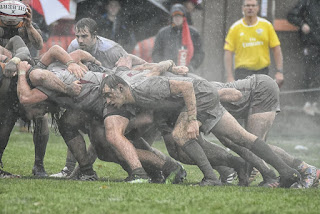In rugby, a scrum is a structured method of restarting play after certain infractions or stoppages. It is a fundamental aspect of the game and is used to contest possession of the ball. The scrum involves eight players from each team, known as forwards, who come together and bind together in a formation to engage with their opponents.
The primary objective of a scrum is for the team with possession of the ball, known as the attacking team, to retain or regain possession. The team not in possession, known as the defending team, aims to disrupt the attacking team and potentially win the ball back. The scrum creates a controlled environment where both teams have an equal opportunity to contest for the ball.
When a scrum is formed, the forwards from both teams bind tightly together, with their heads interlocking and their shoulders in contact. The scrumhalf from the attacking team then feeds the ball into the scrum by rolling it down the tunnel formed by the two sets of forwards. The front rows, consisting of three players on each side, compete for the ball by using their feet to kick it back to their teammates.
Once the ball is in play, the forwards use their strength and technique to push against their opponents, attempting to gain possession of the ball. The players in the second row provide additional support and stability to the scrum, while the back row players can either engage in pushing or act as additional options for the attacking team once the ball is won.
The scrum is a highly technical and physically demanding aspect of rugby. It requires coordination, strength, and timing from the players involved. The referee closely monitors the scrum to ensure fairness and safety, penalizing any infringements or illegal actions.
The scrum is a key component of the game, allowing for tactical decisions and strategies to be employed. It provides an opportunity for teams to demonstrate their strength, technique, and teamwork in a controlled and regulated manner.
Photo: Pixabay (free)

No comments:
Post a Comment
Thanks for your comment.